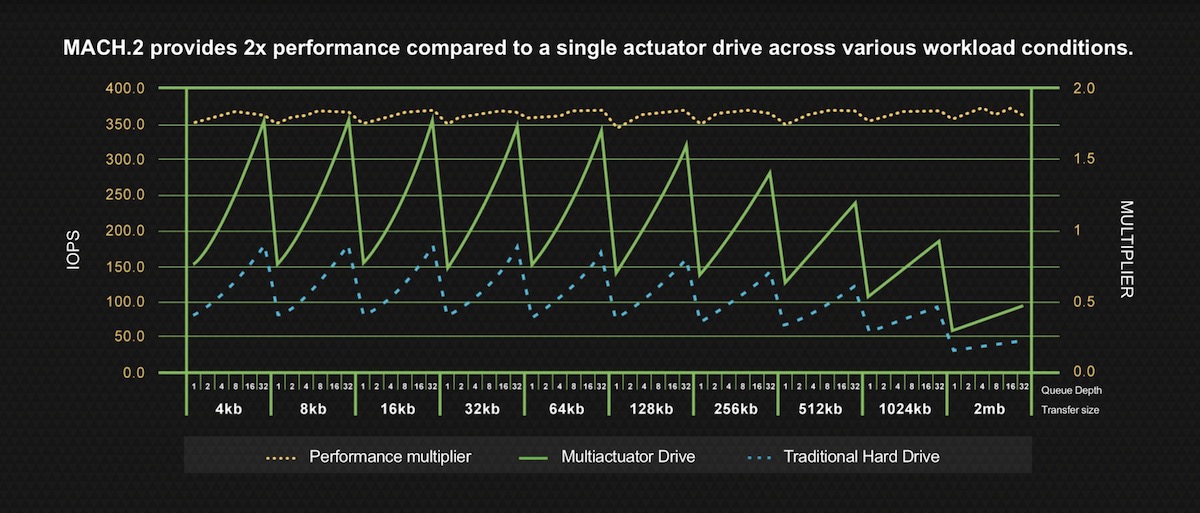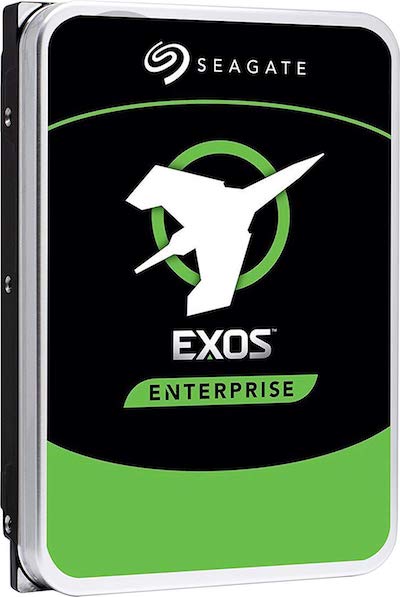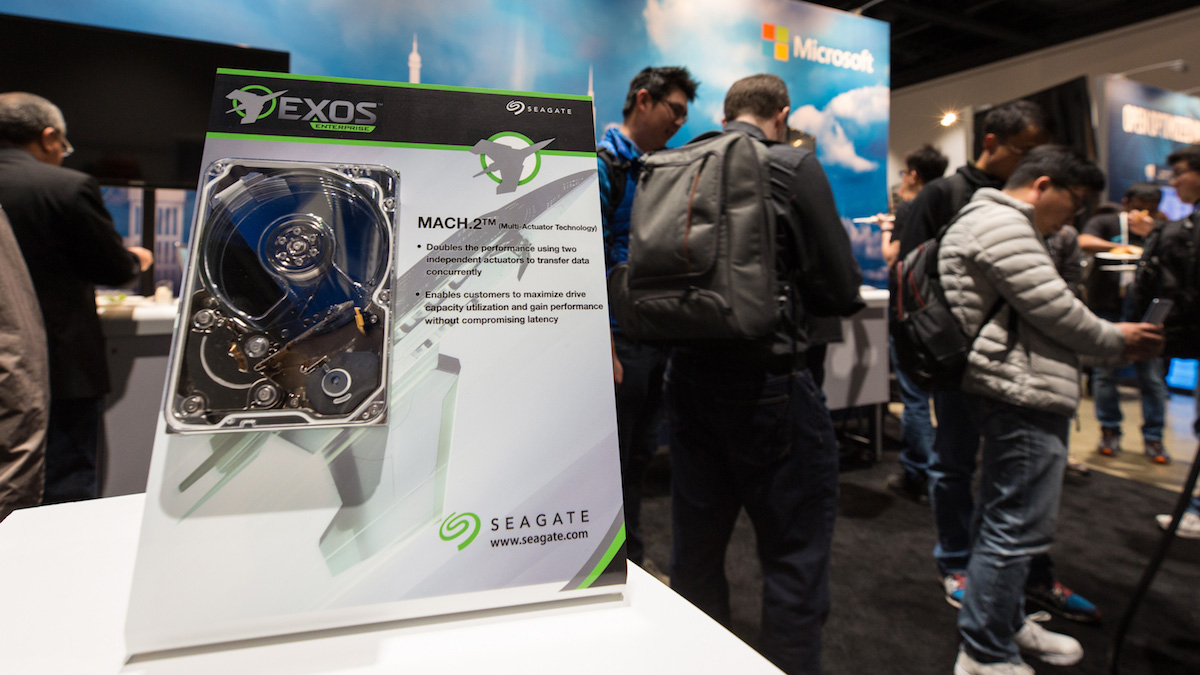Seagate's Mach.2 Technology Doubles HDD Performance, Microsoft Jumps Aboard
Two actuators equals twice the IOPS
Seagate's multi-actuator technology is a simple concept that doubles the performance of a hard drive by using two actuators, and the idea certainly isn't new. In fact, the company has already developed drives with multiple actuators in the past, but they weren't economically viable due to higher component costs.
Now the company has perfected the method to effectively double HDD performance, which you can read about here, and devices are in the wild.

In every cloud data center, floor space is at a premium, and for many applications, cloud providers are trying to get more IOPS out of the same slot. The 14TB Exos 2X14 connects over SAS and presents itself to a server as two 7TB volumes rather than as a single drive. With two actuators, IOs can transfer independently of each other within a single HDD. One actuator addresses the top half of the drive, while the other actuator services the bottom half.

At lower costs per GB and high capacities, HDDs are a good choice for applications such as content delivery networks (CDNs), video streaming, mail servers, backup/shuttle services, Hadoop, and other cloud applications.
But, as capacity increases, performance needs to scale as well. Traditional single actuator HDDs just aren’t cutting it. That’s why Seagate’s Exos 2X14 enterprise hard drive features the company’s MACH.2 dual-actuator technology, and Microsoft has jumped in as an early adopter.
Seagate partnered with Microsoft architect Aaron Ogus deployed the technology in the Microsoft Cloud space and worked on Exos 2X14’s development directly from its infancy.
Seagate’s 14TB Exos 2X14 enterprise hard drive is the first to feature the company’s MACH.2 multi-actuator technology, and Microsoft has just finished initial testing.
Get Tom's Hardware's best news and in-depth reviews, straight to your inbox.
To support all of Microsoft’s CSP services including Azure and Exchange, the company will deploy Seagate’s new Exos MACH.2 drives. The company took a look at interoperability and compatibility with the data center infrastructure as well as robustness, reliability, and ease of integration with its Project Olympus system architecture. Of course, performance factored in.


To evaluate sequential performance, Microsoft simulated backup and streaming operations. The company also simulated hyperscale and CDN workloads for testing random read IOPS and used Microsoft Exchange Server Jetstress tool to simulate Exchange 2013 and Exchange 2016 disk I/O loads.
“Based upon that analysis, we’ve found we are getting close to twice the throughput and IOPS, which are the improvements we expected to achieve with the MACH.2 technology,” says Ogus.
Seagate cloud product manager, James Borden, explains that “to maintain the expected quality of service, a 16TB drive requires twice the maximum throughput capability of an 8TB drive. As your application starts to exceed the maximum IOPS capability of a storage device, the only way to solve that is to put less data on the device — and that equates to stranded capacity.”
Borden explains that, when short stroking, “You put a subset of your data on the outer diameter of a drive and use the internal diameter to store less important data that doesn't need to be delivered with the same quality-of-service metric. In that way, at least you won't have a hard drive that's only two-thirds full. But short stroking still makes data management more complex, and you can’t be certain you’ll always have full utilization of your installed capacity.”
Seagate’s MACH.2 technology boosts the performance Microsoft needs to support their exchange servers at higher capacities to prevent this from happening. It also removes the need to short stroke your storage to improve performance, too.
The Exos MACH.2 HDDs will be available in multiple SKUs to accommodate applicable enterprise use cases as collaboration and development continue, but Seagate hasn't given specifics about when it will open the drives up to the broader market.

Sean is a Contributing Editor at Tom’s Hardware US, covering storage hardware.
-
drtweak Sooo really what they are doing is putting two smaller hard drives in one enclosure. That is all. They should of just said that. Would have made more sense lolReply -
bit_user Reply
Not quite. They rotate on the same spindle. And they obviously share a controller and interface. It really is only the actuator arms that are independent.drtweak said:Sooo really what they are doing is putting two smaller hard drives in one enclosure. That is all. They should of just said that.
There have been prototypes (I'm not sure if any released products) that had two sets of actuators & heads for accessing the same platters. In that case, you would literally have double the bandwidth, or the ability to read & write at the same time. The "deal-breaker" likely has to do with calibrating the two sets of heads. -
NeatOman Would be nice if there is a RAID controller built into the drive when/if this goes to consumers. But maybe one step at a time. Still much cheaper than two 8TB $1500 SSDs vs tiered SSD and HDD if you don't need the SSD performance that much. Double the HDD performance per rack is much more than it's not lol.Reply -
alextheblue Reply
This probably won't see a regular consumer model. Cost is too high. Most consumer applications either don't need a ton of IOPs (mass storage on a secondary large HDD), or benefit from LOTS of IOPS but don't generally need as much capacity (OS + applications, which is better served by an SSD).NeatOman said:Would be nice if there is a RAID controller built into the drive when/if this goes to consumers. But maybe one step at a time. Still much cheaper than two 8TB $1500 SSDs vs tiered SSD and HDD if you don't need the SSD performance that much. Double the HDD performance per rack is much more than it's not lol.
Professional users probably won't care either, since tower space is rarely an issue, and you can RAID a ton of cheaper conventional drives and/or bolster with SSD caches. The only prosumer application that might make sense is a NAS/media server situation, if your NAS is flexible enough (since you're effectively doubling the number of HDDs).
Performance is rather similar to two 7200 RPM enterprise HDDs, but occupies the physical space of one. That should give you a pretty good idea, since that is already a known quantity (as in, awful).bdcrlsn said:I clicked, hoping to see performance figures; should’ve known better. -
bit_user Reply
For future reference: news articles cover announcements, whereas reviews or previews are the types of pieces that would have hands-on performance data.bdcrlsn said:I clicked, hoping to see performance figures; should’ve known better. -
bit_user Reply
Yeah, especially for a small or medium-sized office. Also for database servers and other scenarios where IOPS matter and you wouldn't necessarily just use SSDs.alextheblue said:The only prosumer application that might make sense is a NAS/media server situation, if your NAS is flexible enough (since you're effectively doubling the number of HDDs).
I think it's more like they cut the stack of platters in half and put different actuators on each. So, the best-case scenario is that you might get twice the random IOPS out of it, but I'd expect the sequential transfer rate to be as bad as half of the equivalent conventional drive.alextheblue said:Performance is rather similar to two 7200 RPM enterprise HDDs, but occupies the physical space of one.
Going back and looking at the article, I see the claim:
“Based upon that analysis, we’ve found we are getting close to twice the throughput and IOPS, which are the improvements we expected to achieve with the MACH.2 technology,” says Ogus.
In an IOPS-heavy workload, where much of the time is spent seeking, I would expect throughput to nearly double. However, for more sequential workloads, the only way I see this increasing throughput is if it had more platters than a conventional drive. Either that, or conventional hard drives don't use more than one head at a time, which I doubt.
As for extracting real-world performance out of it, I think a lot has to do with how data is split between the two halves. I can think of cool ways to split it, to suit different specialized use cases.
BTW, hi! -
RussG123 https://www.tomshardware.com/news/seagate-hdd-harddrive,8279.htmlReply
I was just speaking to a friend about how hard drive articles from a decade ago sound the same as the ones coming out now. Funny thing that we're now seeing this article. The link above is from a Tom's article over 10 years ago, speaking on the same topic, vendor and technologies. -
JoBalz ReplyRussG123 said:https://www.tomshardware.com/news/seagate-hdd-harddrive,8279.html
I was just speaking to a friend about how hard drive articles from a decade ago sound the same as the ones coming out now. Funny thing that we're now seeing this article. The link above is from a Tom's article over 10 years ago, speaking on the same topic, vendor and technologies.
HDD has been around for a long time so the technology is fairly mature. That doesn't mean there's not room for improvement. In this case the technology had been attempted in the past but for various reasons it didn't prove feasible at the time. With other improved technologies and production techniques, these HDDs are now economically feasible to produce them since HDDs, As with any mature technology, we won't read about HDDs as often as we do in the rapidly improvements in SSDs.